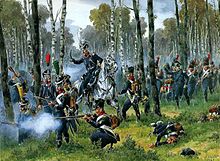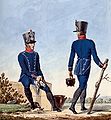Organization of the Napoleonic Army
The organization of the Napoleonic Army (Armée Napoléonienne) concerns the infantry , cavalry , artillery , auxiliary services and command posts.
Command and organizational structure
The Great Headquarters
Although in practice other higher staff had the same tasks, this was, however, tied to the person of the emperor.
The Imperial Staff
The Imperial Staff included all personnel assigned directly to the Emperor, both in Paris and on the battlefield. It was divided into three departments:
- the imperial cabinet with the secretariat (also responsible for espionage and the collection of information about the enemy), the topography office (preparation of battle maps, headed by Joseph Albert Bacler d'Albe ) and the archive (headed by Agathon Fain )
- the emperor's personal staff, consisting of the imperial aides de camp (generals from all branches of the armed forces ): they had to inform the emperor of important points, to pass on his orders to the commanders of the army corps , to check that the imperial orders were carried out and evaluate knowledge gained during battles. These included the infantrymen Andoche Junot and Georges Mouton de Lobau , the cavalryman Jean Rapp , the artilleryman Antoine Drouot and the pioneer Henri-Gatien Bertrand . The number of aides de camp was fixed at 12, each of whom was assigned a number of orderly officers .
- the Imperial Guard, to which the office of the Grand maréchal du palais (Grand Marshal of the Palace) belonged, until his death in 1813 Géraud Christophe Michel Duroc , then Henri-Gatien Bertrand
The General Staff of the Army
The General Staff of the Army (Etat-major général de l'armée) was the supreme command authority of the Grande Armée , in which a large number of specialized officers did their service. From here the orders went to all units.
The Kaiser was particularly demanding of the accuracy and reliability of the command authority and the speed and accuracy of the reports.
The general staff was commanded by a "major général" and consisted of:
- the cabinet of the major général, divided into four departments - secretariat, troop movements, accounting and information. Civilians, retired officers and commissaires des guerres were also employed .
- the actual staff of the major général, in which the aides de camp were summarized. These were officers who were given the task of forwarding orders to the commanders of the army corps. The qualities required were energy, boldness, and initiative because the distances separating headquarters were often considerable and because it was not infrequently dangerous to travel in an area that might be roamed by enemy patrols .
- from three departments for administrative questions, each led by an adjudant-commandant.
The major général was also the deputy commander-in-chief of the French army after Emperor Napoléon . Such a relationship of trust made very high physical and moral demands. He was directly subordinate to the Kaiser and not to the Minister of War.
This post was held by only the following two soldiers:
- 1805 to 1814: Maréchal Louis-Alexandre Berthier
- 1815 ( Reign of the Hundred Days ): Maréchal Nicolas Jean-de-Dieu Soult
infantry
There were two types of infantry, line infantry (Infanterie de ligne) and light infantry (Infanterie légère) . The "Infantry de la Garde impériale" did not differ much from it, but it was an elite force and also had different names for its subgroups.
Infantry de ligne
The line infantry was the backbone of the troops. The regiments were numbered consecutively from 1 to 156, but the 20 numbers were not assigned and were designated as "vacant".
The composition of the regiments varied, but they generally consisted of two or three battalions , occasionally four or five, with the 5th battalion always being a depot battalion. The battalions of the line consisted of six companies , including two elite companies (a grenadier and a voltigeur company ) and four fusilier companies . The latter formed the center of the battle order, while the grenadiers were placed on the right wing and the voltigeurs on the left wing.
The fusilier company had a target stock of
- 3 officers: a captain , a lieutenant and a sous-lieutenant
- 5 NCOs: one sergent major and four sergents
- 92 teams: one caporal fourrier, eight caporals, 80 soldiers and two drummers
The elite companies had a smaller nominal inventory and the fusilier companies were rarely complete. The voltigeurs performed a cornet instead of drums .
The grenadier companies of the line regiments cannot be directly compared with those of the imperial guard. While the former were the elite of their regiment, the latter were the elite of the entire army. In contrast to their designation, the grenadiers no longer carried a grenade, but were only assigned to it on the basis of their brave behavior, at least four years of service and a corresponding body size. In addition, the grenadiers of the line did not wear the guard's fur hat, but a normal shako , even if this was more richly decorated than that of the fusiliers. They also wore epaulettes with red fringes.
The voltigeur companies were not set up until 1805. In theory, the voltigeurs, who were generally of smaller stature, should sit behind cavalrymen, be brought to focal points as quickly and be more mobile than the rest of the infantry. Napoléon was against this practice, however, because it misused the cavalry and thus impaired their actual mission. They were supposed to be equipped with a lighter rifle for this, but this rarely happened. Nonetheless, the voltigeurs were among the elite and received higher wages. Their uniforms had yellow collars and their epaulettes had green fringes. In addition to their actual task of protecting the battalion's left flank, they could also be used as scouts.
Light infantry
In theory, light infantry was intended for operations in difficult terrain (in the forest, when crossing watercourses, in mountainous terrain, etc.), but in practice it was used as normal line infantry. Uniform, armament, equipment, training, tasks and organization were the same as those of the line infantry. The number of these light regiments apparently did not exceed 40. Each regiment consisted of 2 to 3 battalions (five during the reign of the Hundred Days). Each battalion had six companies, two of which were so-called elite companies (the Carabiniers Company and the Voltigeurs Company). The center companies were called hunter companies , but should not be confused with the foot hunters of the Imperial Guard. The difference in uniforms consisted of the dark blue borders of the light infantry, while the line infantry used white borders.
The carabiniers corresponded to the grenadiers of the line and wore the same red epaulettes. A certain height was not important. According to their name, they were supposed to be armed with a carbine, but mostly wielded the normal infantry rifle. However, they were selected from among the best shooters. The voltigeurs of the light infantry became the model for those of the line infantry, which were set up a year later.
Guard infantry

The guard infantry was originally set up to protect the monarch, but was in practice used as an elite reserve. It consisted of the Grenadiers (Grenadiers), Chasseurs (Hunters), (Tirailleurs) Riflemen and the Voltigeurs (Skirmishers). The regiments of grenadiers and hunters belonged to the Old Guard , but some authors also include them in the Middle Guard.
The grenadiers wore a bearskin hat with a brass plaque showing the imperial eagle on the front. There were also silver-plated lacing and a red feather trim on the left side. A mustache was compulsory, and it was also common to wear a gold ring on each ear. A company was 150 to 200 men strong.
- Admission criteria for the Grenadiers of the Guard
In order to be accepted into the 1st regiment of the Grenadiers of the Guard , one had to have distinguished oneself through bravery, many of which were therefore also awarded the Legion of Honor.
The minimum size was set at 1.76 meters, but this could not be kept due to the lack of such tall people.
A twelve-year service in the imperial army was also required, and after ten years of service one, two after 15 years and three after 20 years, should be worn on the sleeve of the uniform.
The "Chasseurs á pied" formed the other part of the Old Guard. Besides the size, the selection process was less strict than that of the grenadiers. In contrast to these, there was no brass plate on the bearskin hat. The best-known of the “Chasseurs à pied” of the Old Guard is without a doubt Général Pierre Cambronne because of the saying he is said to have made at the end of the Battle of Waterloo: The Guard dies, but they do not surrender.
The Tirailleurs and the Voltigeurs belonged to the Young Guard, they wore a shako .
cavalry
The cavalry consisted of the light cavalry (Cavalerie légère) , the line cavalry (Cavalerie de ligne) and the heavy cavalry (Cavalerie lourde) .
A cavalry regiment had a target number of 800 to 1,200 riders, but due to large losses in the battles, the number could shrink by up to 30%.
A regiment consisted of three or four escadrons (but sometimes six or eight). The escadrons were subordinate to the captains with longer periods of service. Each escadron was divided into two companies, each of which was commanded by a captain. Each company had a target number of three officers, four non-commissioned officers, four brigadiers, 74 horsemen and a trumpeter. These numbers changed slightly depending on the unit type.

Cavalerie légère
Napoléon's light cavalry consisted of the hussars , the chasseurs à cheval and the Chevau-légers lanciers . The light cavalry of the Guard ( Cavalerie de la Garde impériale ) consisted of the Lanciers polonais de la Garde impériale and the Lanciers rouges de la Garde impériale (also called "Lanciers rouges" because of the red uniforms), the regiment of the Lanciers lituaniens de la Garde impériale and the regiment chasseurs à cheval de la Garde . For the latter included a Mamelukenescadron (Mamelouks de la Garde impériale) , which consisted of Turkish riders who Napoléon from the expedition to Egypt had brought and carried the oriental uniforms.
In 1813 three regiments of Éclaireurs de la Garde impériale were set up.
The horses of the light cavalry were between 149 and 153 centimeters tall. The color of the horses was predetermined by the use in the respective Escadron:
- 1. Escadron: Rappen
- 2. Escadron: Brown
- 3. Escadron: red foxes
- 4. Escadron: gray mold
In the light cavalry of the line, as in the guard cavalry, there were exotic units that had sprung from the whim of the emperor and had no military value, such as the escadron of the chasseurs à cheval ioniens .
Cavalerie de ligne
The line cavalry consisted of the Lancers and the Dragoons . The dragoons were originally mounted infantry, but have long been counted as cavalry in France. The "Régiment des dragons de la Garde" was also called "Dragons de l'Impératrice" (Dragoons of the Empress), since Joséphine de Beauharnais was the head of the regiment . The horses of these regiments should have a stick measure of 153 to 155 centimeters.
Cavalerie lourde
The heavy cavalry of the Imperial Army consisted of the "Cuirassiers" ( cuirassiers ), the Régiment de carabiniers de la Garde impériale and the Régiment de Grenadiers à cheval de la Garde impériale . The riders had to be of robust stature, their equally stable and specially selected horses had to be between 155 and 160 centimeters tall.
There were 14 cuirassier regiments whose task it was to break through the enemy infantry lines and attack enemy cavalry. The cuirassiers were protected by the cuirass , which consisted of three millimeters thick sheet iron and weighed seven kilograms. It protected the upper body against saber blows and, but only to a certain extent, against rifle and pistol bullets. On his head the cuirassier wore an iron helmet with a comb from which a long black ponytail hung to protect the neck. He was armed with a saber , a pistolet and a musket , which usually hung on his back.
The carabiniers, whose tasks were similar to those of the cuirassiers, also wore a cuirass since 1810, but made of yellow metal. This equipment with the cuirass went back to an order of Napoléon after the heavy losses in the fight against Austrian Uhlans in 1809.
artillery
Napoleon's artillery consisted of three types of units: “Compagnie d'artillerie à pied” ( foot artillery company ), “Compagnie d'artillerie à cheval” ( mounted artillery company ) and “Compagnie du train” ( trainee company ). The units are sometimes referred to as a battery , but this is incorrect because a "battery" consisted of several guns in the firing position. The personnel of the foot and mounted artillery companies were only responsible for using the guns. The training company was responsible for the transport.
The foot artillery company was 120 men strong (1 officer, 10 NCOs and 106 men). The soldiers did not have riding horses, but went on foot.
The mounted company was 100 men strong (4 officers, 10 NCOs and 86 men). Every man was mounted.
The training company had a target population of 141 men (1 officer, 14 NCOs and 126 men). She had 20 riding horses and 230 draft horses.
If possible, the draft horses should not be left in the immediate vicinity of the battle.
The artillery pieces were 4-, 6-, 8-, or 12-pounders and 5-inch or 6-inch mortars .
A battery in the firing position of the foot artillery consisted of six cannons and two mortars, a mounted battery consisted of 4 cannons and 2 mortars.
Four horses were used to pull a cannon or a mortar, but six horses were used for a 12-pounder. The ammunition carts were also pulled by four horses. Three ammunition carts were provided per cannon.
literature
- Liliane and Fred Funcken: L'uniforme et les armes des soldats du Premier Empire. Volume 1: of the regiments de ligne français aux troupes britanniques, prussiennes et espagnoles. Casterman, Tournai 1968, ISBN 978-2-203-14305-0 . Volume 2: de la garde impériale aux troupes alliées, suédoises, autrichiennes et russes. Casterman, Tournai 1969, ISBN 978-2-203-14306-7 .
- Oleg Sokolov: L'Armée de Napoléon (with a foreword by Jean Tulard ). Commios, Saint-Germain-en-Laye 2003, ISBN 978-2-9518364-1-9 .
- Émile Marco de Saint-Hilaire: Histoire anecdotique, politique et militaire de la Garde impériale. Eugène Penaud, Paris 1847 ( digitized on Gallica ).
- Henry Lachouque: Waterloo. 1815. Éditions Stock, Paris 1972.
- Yves Martin: Les Aigles en Espagne. La garde de Paris. In: Tradition. No. 275, September / October 2014, pp. 14-17.
- Jean-Claude Lorblanchès: Les soldiers de Napoléon en Espagne et au Portugal. 1807-1814. L'Harmattan, 2007, ISBN 978-2-296-02477-9 ( limited preview in Google Book Search).
- Alain Pigeard: Les légions polonaises d'Italie et du Danube. In tradition. No. 8 (hors-série): Napoléon et les troupes polonaises 1797–1815: De l'Armée d'Italie à la Grande Armée. January 1, 1999.
- Alain Pigeard: La Conscription au temps de Napoléon 1798-1814. Bernard Giovanangeli, Paris 2003, ISBN 978-2-909034-45-4 ( limited preview in Google book search).
- Georges Six: Les généraux de la Révolution et de l'Empire. Bernard Giovanangeli, 2002, ISBN 978-2-909034-29-4 . New edition: 2003, 978-2-7028-8517-8.
- René Chartrand; Francis Back (Ill.): Napoleon's Overseas Army (= Men-at-Arms , No. 211). Osprey Publishing, Oxford 1989, ISBN 978-0-85045-900-5 .
Footnotes
- ↑ Major was not a rank, but the name for an organizational head.
- ↑ not a rank, but a position
- ↑ The depot battalion was responsible for the replacement of personnel and their training.
- ↑ Apart from the first part nothing was realized.
- ↑ a reconnaissance force according to its name, for which it was not used
Web links
- L'armée française ( Memento of June 16, 2012 in the Internet Archive ). In: L'aigle conquérant
- Napoleon's Overseas Army. Osprey Publishing, Oxford website
















